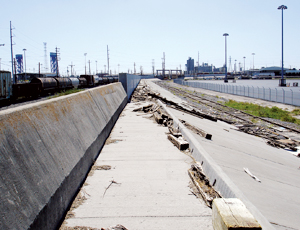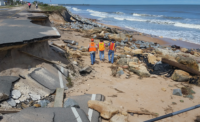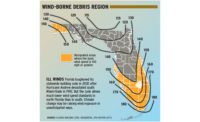New Orleans’ hurricane and storm damage risk-reduction system is much improved since Hurricane Katrina, but protecting lives will continue to require an emphasis on evacuation, especially until 2011, when the 100-year protection levels are scheduled to be in place. The risk remains high.

Those are the findings of a reconnaissance team sponsored by the National Science Foundation, through the Geoengineering Extreme Events Reconnaissance Association. The team’s inspections last October assessed system performance in Hurricane Gustav’s Sept. 1 landfall. The team plans to release its report by the end of the month.
The reconnaissance was the first GEER-sponsored review of a nonearthquake event, says Jonathan Bray, a professor of geotechnical engineering at the University of California at Berkeley and a member of the GEER steering committee. "We were primarily developed for earthquake events but, after Katrina, we realized we should go to multi hazards: any event or hazard that has a potential for us to learn lessons in geoengineering," Bray says.
The scope change for GEER reflects lessons of Hurricane Katrina, says Bray. "What we want to do is calibrate our understanding and analytical tools so we have confidence when we design in the future that we are not being too conservative, or not conservative enough, but [that] we are getting it right," he says.
In Gustav, "the system did well," says Robert Gilbert, a civil engineering professor at the University of Texas at Austin and one of the team leaders. "[It] was loaded in some cases to its design capacity....On the Inner Harbor Navigation Canal, where the Gulf Intracoastal Waterway comes in, all the field evidence indicates that the actual still water elevation got over the top of the [flood] wall."
Although Katrina’s flood loads were higher than Gustav’s, the primary difference in the performance of the walls, gates, earthen levees, pumps and interior drainage canals constructed or improved to new criteria since Katrina is that during Gustav the features worked, says co-leader Lee Wooten, a civil engineer with geotechnical concentration, and principal of GEI Consultants Inc., Woburn, Mass. "Everything that was under federal control performed as designed during Gustav," Wooten says.
That assessment, as well as the good performance of the interim gate closure structures and pumps on the city’s three outfall canals, gives confidence to engineers involved in the continuing work to meet the 2011 deadline, says Timothy Ruppert, supervisory civil engineer in the U.S. Army Corps of Engineers’ New Orleans District engineering division. Ken Klaus, civil engineer with the Corps’ Mississippi Valley Division in Vicksburg, says, "Seldom do we have a storm loading shortly after construction and while we are still in design mode for the 1% event. Now we move forward with confidence gained from these events."
Ruppert and Klaus were among several Corps engineers invited to accompany the NSF/GEER team. Wooten, who also participated in an NSF-sponsored inquest after Katrina, and Gilbert say they felt it important to coordinate with the Corps and the American Society of Civil Engineers to make sure everyone knew what they were looking at and that uniform criteria were applied. "You need people who understand how the Corps designs and builds things, and have them explain what is going on at a particular location," Gilbert says.
D. Wayne Klotz, ASCE president, lauded the effort and the team selection. "ASCE’s mission is to promote engineering excellence, in part through studies such as this," Klotz says. "Much can be learned from such disasters, and the team’s findings could have a large impact on the practice of engineering, as well as be an immeasurable benefit to the public."



Post a comment to this article
Report Abusive Comment